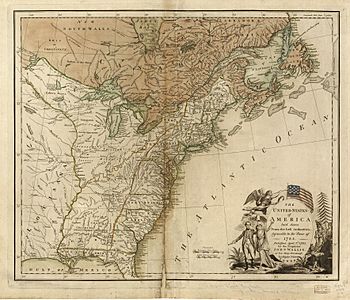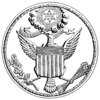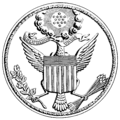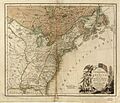Confederation period facts for kids
Quick facts for kids
United States of America
|
|||||||
|---|---|---|---|---|---|---|---|
| 1781–1789 The Confederation Period came to a close with the adoption of the 1789 Constitution |
|||||||
|
Anthem: None official
|
|||||||

Map of the United States in 1783
|
|||||||
| Capital | Philadelphia (1781-1783) Princeton (1783) Annapolis (1783-1784) Trenton (1784) New York City (1784-1789) |
||||||
| Common languages | |||||||
| Religion | Majority: Protestantism Minority: Catholicism Judaism Native American religions |
||||||
| Government | Confederal republic | ||||||
| President of the Congress | |||||||
|
• 1779–1781
|
Samuel Huntington (first) | ||||||
|
• 1788
|
Cyrus Griffin (last) | ||||||
| Legislature | Congress of the Confederation | ||||||
| Historical era | American Revolution | ||||||
|
• Articles of Confederation came to effect
|
1 March 1781 | ||||||
| September 1781 | |||||||
| June 1783 | |||||||
|
• Signing of the Treaty of Paris
|
September 1783 | ||||||
|
• Constitutional Convention begins
|
May 1787 | ||||||
| August 1787 | |||||||
|
• States begin ratification of Constitution
|
December 1787 | ||||||
|
• Articles of Confederation superseded by 1789 Constitution
|
4 March 1789 | ||||||
| Currency | Continental Currency | ||||||
|
|||||||
The Confederation Period was a time in United States history during the 1780s. It happened right after the American Revolution and before the U.S. Constitution was put into effect.
In 1781, the United States approved the Articles of Confederation. This was like their first rulebook for the country. That same year, American forces won the Battle of Yorktown. This was the last big land battle of the American Revolutionary War. In 1783, the Treaty of Paris was signed, officially making the U.S. an independent nation.
During this period, the new United States faced many problems. There wasn't a strong central government to unite the states. This era ended in 1789 when the U.S. Constitution was approved. The Constitution created a new, stronger national government.
Contents
What Were the Articles of Confederation?
The Articles of Confederation created a very loose union of states. It gave the national government very little power. An assembly of delegates (representatives) acted for their states. This group, called the United States in Congress Assembled, had almost no authority. It couldn't do much without the states agreeing.
Why the Government Was Weak
The government under the Articles had no single leader, like a president. It also had no court system. Congress could not collect taxes from the states. It couldn't control trade between states or with other countries. This made it hard to deal with foreign powers.
Because Congress was so weak, important leaders often chose to work in state governments instead. The national government struggled to solve the country's problems. This led many people to want changes or even for states to leave the union.
Challenges for the New Nation
After the Treaty of Paris, the United States owned a huge area of land. This land stretched from the Atlantic Ocean to the Mississippi River. But settling these new lands was difficult.
Problems with Land and Neighbors
Native American groups resisted new settlements. Also, Great Britain and Spain were still nearby. The British refused to leave American territory. Spain controlled the Mississippi River, which made it hard for settlers to move west.
The Northwest Ordinance
In 1787, Congress passed the Northwest Ordinance. This was a very important law. It created the first organized territory controlled by the national government. This set a pattern for how new areas would become states later on.
Moving Towards a Stronger Government
Congress tried to fix the Articles of Confederation, but they failed. So, in 1787, many national leaders met in Philadelphia. Their goal was to create a brand new constitution.
The new Constitution was approved in 1788. The new federal government started meeting in 1789. This marked the official end of the Confederation Period. It was the start of a new, more unified United States.
Images for kids






